Cairo and Cruisin' on the Nile: UniWorld Egypt Tour, October/November 2024
There seems to be no set driving lanes: sometimes it's three lanes, sometimes it's two, sometimes it's four, and horns are freely used instead of turn signals: “beep beep hey I'm here” “here I come into your lane.” In the US we'd take all this horn action as acts of aggression and rage; in Egypt, it's all about courtesy and gentle warnings and reminders. We almost hit a food delivery driver on a motorcycle as he crossed 3 lanes into the left U-turn lane and there are lots of U-turn lanes--to make left turns you really don't make left turns on their roads, you use this U- turn lane and double back for a bit. We're staying at the Ritz Carlton Nile, and upgraded to room 530 Nile view. Melatonin by the time we settled in at 11:30 and i slept well.
November 1st: great night sleep: about 8 hours, melatonin worked well.
The usual fantastic buffet brekkies then Uber’d to the GEM (Grand Egyptian Museum that had just opened a couple of weeks prior) which was fantastic despite not being quite finished. There is a massive main hall dominated by a huge Rameses II statue, with 12 exhibit rooms chronologically arranged, For about a billion dollars and long delays, it was very well done—definitely a World Class Museum. We had lunch at 3 in the museum: tabouli for me. Uber’d back by 5:00 PM dinner of snacks by the pool at the outside bar. Previously unknown Fact: Friday and Saturday are their weekends. Warning: do not bring a camera to the GEM; they make you check it rather haphazardly in their small check room. But phone cameras abound, so the rule makes little sense.
The GEM was not too crowded as it had just opened to the public a couple of weeks prior; Marcia scored tickets on-line before she left. It was definitely built to handle huge crowds: the entry Plaza is enormous with sun shelter areas for long waiting lines that are anticipated, we assume. There were more eating options and several shops in the museum--smart planning.
November 2nd: Ritz Carlton the last day.
No Joan as she fell getting into the Uber yesterday so she's staying in the room she's sharing with Marcia. Again breakfast buffet: we tried more unusual breakfast food recommended by Mohammed--tahini with black honey to dip and fried halloumi cheese on Egyptian bread...excellent! Today we tackled the old Egyptian Museum of Cairo (EMC) which was right next to the hotel, so we waited in line and went in. There was a massive crowd even at 9:30 funneling through several pinch points: their initial x-ray scan at the narrow entry gate (two lines but still, everyone going to the museum funneled through there), and then ticket window line to buy a ticket, and as a massive crowd funneling through the front door to get your ticket checked and then another scan. The EMC is a tired old (100+ year old) museum but we see the reason for GEM’s massive plaza as it will handle crowds much much better. Later we learned that once the GEM is complete, and all the artifacts are moved as planned, the EMC will be rehabilitated and focus on the artifacts from the Greco-Roman period of Pharaonic history (Ptolemy and Cleopatra era).
We (Marcia, Janet and I) managed to skirt most of the crowds but the displays were tired looking--old antique store cabinets and many things already taken to the GEM, and placards, if they were on a display at all, were as small as index cards with typewritten sized font--fugetabout reading them. Janet and Marcia left at 11:30 due to the place filling up. I stayed until 1:00 for 2:00 PM checkout but Janet extended it to 3:00PM. I saw everything but the line for King Tut room (featuring his gold death mask among other artifacts) seemed too long and we will come back to the this museum as part of our tour. Tut will have its own building in the new GEM but it has not moved yet. I bailed without seeing Tut's exhibit.
We checked out of the Ritz, Uber’d the one kilometer to The Four Seasons to start Uniworld tour which kicks off at 7:50 AM tomorrow morning. Dinner in the hotel again as it is a bit chaotic to venture out of our luxury surroundings, so we ate dinner at the bar. I had the local beer (Sakara) and a Croque Monsieur for me, salmon for Janet. Joan did a face plant coming off the raised bar area; eight men in suits came to her aid, more than likely hotel lawyers.
November 3rd: the first UniWorld day
Today was a 7:50 AM start but it turned out to be an orientation meeting and pay for your extra excursions meeting. We previously added the Abu Simbel option, and then found out there was a private night tour of the Luxor temple complex which we scored. We took a pass on the hot-air balloon ride over the Valley of the Kings, and the "sand surfing" in Aswan.
We found out we were assigned Bus 2 with Essam as our Egyptologist. As a group we bussed back the ONE kilometer to the old museum (which took a good half hour!) but now we were with our Egyptologist and our group about 50 people but it was so much more crowded with large groups disgorged from more busses, including ours, all going through the single narrow entrance gate. And, once in the museum, those led-groups were gathered around and blocking all of the best displays (so we were glad we had our own time in there the day before). No guides were allowed in the Tut room, but we waited only about 5 minutes in a long line to see the artifacts as the docents in the room kept the crowds moving and policing the "no photos" rule effectively. As we found throughout the trip, guides were not allowed in "special exhibits" which definitely helps with the traffic flow in and out of them.
Once out of the EMC we went to our bus and took a long trafficky ride to the Cairo Citadel and the Alabaster Mosque, which was a copy of Istanbul’s Blue Mosque. After a quick spin around the "cleansing temple" outside the mosque and the beautiful mosque itself, we piled in the bus for another long (time wise) and traffic-clogged ride to the New Museum of Egyptian Civilization (NMEC). One does not get anywhere fast in Cairo, neither on highway nor surface street, nor at any time of day it seems. Essam said their rush hour has reduced from 18 hours a day to 17! And it looks like the government thinks that building elevated highways would solve the problem—elevated highways crisscross and circle Cairo, but traffic is still pretty much at a standstill everywhere we went.
The NMEC is a very well done museum--they took twenty two of the most important mummies out of the EMC and put them in a underground chamber-like gallery to specifically highlight these mummies: there are a couple of Thutmoses, 5 or 6 Rameses, Hatshepsut and others. The walls are dark marble and you wind your way from mummy to mummy much like you would do in the Valley of the Kings crypts. We found out later that Tutanhkamon's mummy remains at the Valley of the Kings in his original crypt. NMEC's mummies were brought from the old museum in nitrogen filled boxes in specially decorated trucks in a crazy, hyper-staged parade to open the museum in April 2021. I wish they kept and displayed on of the trucks at the museum. Search "NMEC parade" on YouTube or see if this link works: Watch this YouTube: https://www.youtube.com/watch?v=IegmrsDbxk4
Again, a crawling bus ride back to the Four Seasons, and we liked the bar dinner so much that we made a clean sweep of the salmon on offer and ended the day early as tomorrow was the transfer flight to Luxor to board our boat, the Sphinx—a 5:45am start to the day tomorrow. Needless to say, Joan got a great deal of attention from the men in suits as we left the bar and descended the stairs.
November 4th: airport at Cairo—essentially a charter for UniWorld and Viking boats flying to Luxor. The flight was scheduled for 7:30 but we didn't get out until 7:45 or off the ground until 8:30-ish. I think it was a CairoAir or AirCairo flight from the domestic terminal and it loaded just outside of the door into a bus and then you drove out to the tarmac and then up stairs into the plane. It was a short one hour flight to Luxor then we were bussed to the Karnak temple complex--very, very impressive but quite crowded by the time we arrived. Essam is a former cop so he barks orders in Arabic to the other guides to get them out of our way. How dare there be other people there!
It is a massive complex with 127 columns throughout the complex. “Influencers” were posing: mostly pasty white Asian women with their uglier friends or boyfriends taking the shot, then they go over and check the photo and go through another round of posing with their flowing veils and dresses. A short bus ride (distance) that took a while got us to the boat and we were assigned cabin 108, larger than the Bordeaux cabin but not by much.
We had the usual excellent buffet lunch and set sail north for the short trip to Dendera. Janet got some great shots of the sunset over the red cliffs to the west as we sailed north. We had a lazy afternoon reading on the top deck, with a nice wind to keep it cool. The temps stayed pretty consistent throughout the trip: low to mid-80s, but the air quality was dreadful validating our decision to skip the hot air balloon ride over the Valley of the Kings the next day. All the car and diesel exhaust from transportation, the smoking diesel pumps for the farmers pulling water out of the Nile, and the farmers burning their agricultural waste let to very hazy days and AQI numbers from 100 (not so good for sensitive people) to a high of 158 (downright unhealthy).
Breakfasts and lunches on the boat are from a buffet but the dinner you get a menu and order off the menu, They have generally “regular” food but they also have a “local menu.” I had rare steak with wine from the local menu and the local Egyptian red wine that first night. We always ordered from the “local menu” on this trip.
November 5: US Election Day, which is the day we chose this trip to be out of the country
A 6am bus got us to the Temple of Hathor before ANYONE ELSE! Great planning, UniWorld! Essam barked at the guard at the Temple entrance for smoking within the temple. Excellent. Come to think of it, there was no smoking anywhere on our trip: the hotels were non-smoking except for a hookah lounge on the fifth floor of the Cairo Four Seasons and the boat had a similar hookah lounge in the back corner of the dining room, but it seemed to be unused on the trip. The ass-end of the upper deck also had a smoking area, but I don't think anyone on our ship smoked.
Hathor was the goddess of music, dance, joy, love, sexuality and maternal care, and this temple is one of the best-preserved temple complexes in Egypt. We were there early in the day before it heated up, and we climbed a narrow circuitous stairway up to the roof which was still intact.
The Temple of Hathor, Dendera That's Essam in the Tilley fedora and blue jacket |
November 6: We got the dreadful and unbelievable news...we have Trump 2.0...ugh.
The buses crossed the Nile to west bank and our first stop was the Colossi of Memnon, two large statues that are the only remains of the Temple of Amenhotep III. The pullout for photographing the Colossi was ringed by little junk shops, all with very aggressive vendors who descend on the cars and busses to sell their wares. Essam always asserted to "support these local vendors that support the economy," but would say "it's mostly junk" in the same breath. I found it best to avoid eye contact and not engage them at all, even with a firm "No" as it only served to get them more excited.
We then drove up a twisty road up in to the hills above the Nile, parked and scanned our tickets, then got on large golf carts to go further up to the tombs. Our tickets allowed us to descend in to three tombs plus King Tut's, so we followed Essam to the three typically visited tombs. The Valley of the Kings was seen as an innovation in funerary architecture as the early tombs were so clearly marked by massive pyramids (hey, lots of gold and jewels are buried here!) that it became necessary to bury the tombs deep underground in some bleak and foreboding hills away from the Nile. But these tombs were also looted; so much for innovation. Janet took pictures of each tomb placard into which we descended, and each involved going a couple of stories down a stairway down to long hallways decorated in chants and prayers rendered in hieroglyphics.
The tombs are numbered with a KV (Kings Valley plus a number) and the documentary we watched before we left stressed not to miss KV9, the tomb of Rameses V and VI.
One of the deeper tombs, with many side chambers, and you get a feel how elaborately decorated these tombs are. |
The honest to goodness mummy of King Tut, kept in his tomb in the Valley of the Kings. All other artifacts, including the gold Death Mask and Coffin, and the canopic jar chest, are in the EMC, soon to move to the GEM |
Alas, when we finished using up our tickets with the three Essam-approved tombs, KV9 was yet to be seen. Joan had only used one of her tomb punches, so I (tried to) use it to go to KV9, but the ticket puncher said it was "special entry" like Tut's and required another ticket. As I hoped only to dash in and see what was so cool about KV9, I didn't have time to go back to the ticket office and buy the additional ticket for EP180=$3.66. Hell, I should've bribed the guy with a five!
Then it was back to the boat to eat (of course) and set sail for Kom Ombo and the Temple of Sobek.
A Diversion--Road and Driving Impressions:
- Speed bumps, like in Jordan, are used everywhere, and I noticed they are at intersections in all directions. It effectively slows everyone down entering an intersection, no doubt preventing a lot of T-Bones. And it seemed like every road, in town or rural, had regularly spaced speed bumps, much more so than in Jordan. Jordan had them in regular intervals in towns and villages, but none on the "open road"; Egypt had them seemingly everywhere on all roads. Our bus would get going up to speed, then slow to go over a bump...wash, rinse, repeat.
- Lanes: again, merely a suggestion, particularly in Cairo, but also on rural roads where bus traffic competes with mule carts, pedestrians, motorbikes and motorcycles, minibuses and trucks.
- Honking: our driver also used it freely, when passing, changing lanes, or making one of his famous swing wide right to make a U-turn.
- Bus "Service": Hani said there is no bus service as we know it; there seems to be some semblance of bus service with blue busses in Cairo, but more typically groups of people gather, either on roads or climb up on elevated highways, and flag down these white small jitney busses (more like minivans) with specific hand signals as to where they wish to go. It seems like they operate more like our casual car-pools, and from the number of these white vans one the roads or waiting alongside, it's a big business.
- Trash: there isn''t the massive amount of trash surrounding trash cans and dumpsters like in Jordan--Jordanians seem to make an honest attempt to dispose of things properly but it must never get picked up. There is much less trash around in Egypt, but there is a lot of rubble on top of buildings and in lots. Then we heard that the government is on a crash road and subway building program which may account for some of the rubble.
After Valley of the Kings, Hatshepsut, and alabaster, we were back to the boat by lunch time (buffet time!) and set sail south for Kom Ombo. We've done one other UniWorld cruise (Bordeaux river) so we were invited to a reception in the bar at 6:30...there we sat with Pat and her son Tom. Tom was the youngest person on the cruise, and was constantly head down looking at his phone, wherever we were. And, I was getting a little annoyed at him since he wasn't helping his mom on or off the bus (big steps for her somewhat restricted mobility). It turns out Pat is a wealthy widow from Sacramento, and Tom is (we assumed) a trust-fund baby doing his "business" on the trip. He lives in Columbia and Costa Rica, and his business was a nebulous "WhatsApp-based business assisting people getting multiple passports." And he tossed out some "Wellness Initiative" and "AI" talk while researching is Hungarian heritage which led us to our trust funding assumption. Must be nice... Now we know why he is constantly looking at his phone; it's his "business."
November 7: We docked that previous night right at the Temple of Sobek, so no bus was involved in touring the Temple and the associated Museum of Crocodile Mummies. But there was a particularly persistent gauntlet of crap vendors to negotiate on the 50 yards to and from the temple and museum. The temple was built in the Greco-Roman era and as the temple was unearthed recently, all the mummies found were moved to a small museum next door to the temple. The Nile north of the Aswan dams (yes, there are two) is crocodile (and hippo) free, but they were revered by the ancients as the God Sobek. Essam joked that "Nile crocs ate fish and fishermen." Evidently some crocs were captured and kept in pools near the temple, and when the crocs passed, they were mummified--the ancients liked to mummify animals: there was a small gallery in the EMC that had mummified baboons, snakes, and birds.
Another money shot: the Temple of that Egomaniacal Rameses 2.0 |
That's Marcia with Janet |
Nefertari, Rameses the Great's wife, got her own temple, just to the right of his, and it was wholesale moved up the mountain as well. | Rameses, second from the right, is flanked by two gods and all three get lit up on two days a year, but Ptah, on the far left doesn't since he's the God of Darkness |
On scaffolding at the back wall of the temple, workers are using lasers to find the ancient colors they are using to restore the paintings on the carved walls, columns, and ceilings |
The remarkably well preserved interior of the Temple of Khnum |
We had the usual airport argy bargy with multiple scans, men's and women's pat downs, and an hour or so flight back up to Cairo. Things went rather smoothly until our luggage, for all of us, didn't come up for a while, but we eventually got rolling out of the airport, some on one bus who just wanted to go directly to the Four Seasons, the other two busses going on to the GEM. On a second visit, with Essam, it really is one of the top museums in the world, and I've been to a lot of them like the Louvre and British Museum, and the Met. and they really did an outstanding job going from a blank slate and designing a museum to dramatically show the best of the Pharaonic culture. The Grand Staircase rises across length of the entry lobby, with the left side rising up through about a dozen seated statues up to a chronological display of the timeline of their Kingdoms, and the right side of the massive staircase has many more statues and columns that rise up three times higher than the left side. So you can wander up the staircase checking out all the artifacts, or if you have an Egyptologist like we did in a bit of a hurry, there is a full length escalator that goes to the top of the staircase.
At the end of each of the top galleries, they designed it so you have a view of the Giza pyramids in the near distance. It will be nirvana for those damn "influencers" and their flowing gowns, scarves and capes to prance around for their TikToks for their tens of followers. The only saving grace is that cameras are not allowed in the GEM so it will only be plagued by phones and selfie sticks in the future.
Essam gave a pretty quick overview of the key artifacts throughout the Grand Staircase and in each of the chronologically arranged 12 galleries. I would have been annoyed if that was the only exposure to that museum, but since we spent four hours there before the tour started, we spent our 90 minutes of "free time" to sample the gelato at their parlor and allowed time for Marcia and Janet to shop at the Museum Shop.
We highly recommend that if you choose to come on a tour to Egypt, come or stay an extra day or two to acclimate to the time difference and spend an entire day at the GEM. Seeing it as part of a tour does not do it justice. Just like any other great museum, I could spend the entire day there.
Back to the bus, and the 10 km from the GEM to the Four Seasons took over an hour in the insane traffic of Cairo. We had a final dinner at the hotel buffet with UniWorld.
November 12: Giza and Saqqara Pyramids Day
Another early (7am) bus for the last day of the UniWorld Tour. The air pollution was getting to everyone on the tour, and I checked the Air Quality Index app for Cairo that day: it was 150, Unhealthy! No wonder we were all coughing and our eyes were red. I checked it periodically for the next two days and it never got under 150, and was as high as 158.
We stopped at the "main" pyramid plateau first, featuring the biggest of them all, the pyramid of Khufu/Cheops. There were lots of mule carriage and camel rides going between the sites on the plateau, but much to my chagrin, and appealing to the security of the group, we were bussed between each of the sites: the main pyramids, the "panorama" sitting slightly above the pyramids (under construction) but will be a cluster of shops, restaurants and Temples of Relief. We did get some good shots of the pyramids with resting camels in the foreground at the "panorama."
I noticed this very "James Bond" looking dude following us around, with a large sidearm under his suit jacket. I turns out her was our "security" for the day and hung with us all day. |
We worked our way from the main pyramids to a smaller pyramid, that of Menkaure, that had a very small tunnel access to the deep-in burial chamber. I checked it out but it was a tight fit, so a non-starter for me; Janet and Marcia gleefully hunched down and went to the bottom, their smaller stature being a decided advantage. These burial chambers are not decorated with carvings and paintings like the later kingdom ones at the Valley of the Kings.
From Menkaure's pyramid we bussed around and down to the vantage point for the Sphinx, which is smaller IRL compared to the pyramids, but the pictures and perspective makes it look huge. It's still an impressive sight, and Essam got all the women on the tour to line up and get pictures of them "kissing" the Sphinx.
At the Sphinx overlook, there was the ever-present "influencer" in a blue formal gown, sexily posing for snaps, checking the results, then heading back to the edge for more poses. Oy...
From the Sphinx we headed over to Saqqara, but on the way we stopped at a carpet manufacturing school. We saw six people working on two carpets: they only work 20 minute shifts over 2 hours, no more. But looking at their flying hands making each knot with the correct color while sitting at the loom, it made sense that their hands, arms, and backs needed frequent breaks. They also had a silk cocoon tub working, as the soaking cocoons were unwrapped to a spinning loom...never seen that before. They looked like boiling beans as the 20 cocoons were unwrapping bobbing in the tub.
The Four Seasons prepared box lunches for us, but rather than taking over the nice garden at the school, we sat on the bus, eating away. From there we headed up to Saqqara, and there were active digs like we saw on the Dr. Hawass documentary; obviously, there is still much to be found at this relatively recent site.
The Saqqara step pyramid is considered the first known human-built stone structure monument: the 4,700 year old tomb of pharaoh Djoser. The pyramid only reopened in 2020 after a 14 year restoration project brought on from a 5.8 earthquake in 1992. We almost had the place to ourselves and we descended in to the burial chamber, this one being bigger with a reinforced ceiling which overcame my claustraphobia as I got to peer down in to the 100 foot deep burial chamber, Again, no adornments on these walls going in to the pyramid, after all it is nearly 5,000 years old.
From Saqqara, we went to an "Egyptian cotton" store, where there was much negotiation for a final purchase of a tablecloth and napkins. I really wanted the black Tut Death Mask sheet set, but Janet vetoed that wish!
At an early point on the trip, Essam when on a little unprompted rant in the bus about how transgender was just "not natural" so I think someone got to him to complain about that little aside (we thought, yeah yeah, this is a conservative country so just let it go). On our crawling return to the hotel, Essam went on to tell us (after saying he had no tours until mid-January earlier) that he was leading a Thanksgiving Gay Boat Tour, where a group of (obviously very well off) gay men booked the classic cruise boat "Karim" (look it up, it's an original Nile cruise paddlewheel) and he's led this group for a dozen years. They bring the turkey and the fixin's and they have a grand old time. Maybe he made this up to compensate for being called out for his previous comment...hmmm.
We all said our goodbyes to Hani and Essam once back to the hotel, and for UniWorld, the tour was over. The local "coordinator" however was not done; he scheduled airport transportation for all of us heading home or elsewhere. Some folks had very late or red eye flights that night, but we were heading out the next day late for an after-midnight flight to Frankfurt.
For dinner on our own, we stayed in the hotel and had a Levantine selection for dinner, and we'd have a day to burn tomorrow before our flight. Janet asked for late checkout the next day but were told they were full but they'd give us until 1pm to checkout.
November 13: Kill Time before out Flight
To kill time until checkout, Janet, Marcia and I braved the Mean Streets of Cairo to walk the one mile up to the Ritz to do more shopping. The city is definitely not "pedestrian or bike friendly" as the sidewalks are all busted up and narrow, cars are parked everywhere, and, following the local's' lead, one just walks in the street and hopes drivers are skilled enough to miss you. We passed the American and British Embassy Compounts with dozens of Egyptian police and military stationed all around on the streets. We had to cross busy streets at Tahir Square (site of the Arab Spring protests) and you just learn to follow a local when they choose to walk across the boulevard. Lights and crosswalks and walk signs...nah...
Crossing to Tahir Square, the site of Arab Spring protests. |
AQI was still dreadful, but we got a little exercise with our 2.15 mile loop. In attempting to cross a main boulevard coming off a bridge crossing the Nile, we attached ourselves to a young man to mirror his crossing of a busy six lane road. We made it, and he chatted us up as we walked along the Nile. I was hoping he was just a local worker heading back after lunch, but he actually had a little gift shop and he dragged Marcia and Janet in to "give" them a papyrus with their names in Arabic on them, and Janet, feeling guilty, bought a cool Anubis papyrus so we could be on our way.
I didn't note it, but one of the days we stopped at a papyrus shop and got a demo on how papyrus is made...quite fascinating as, once soaked, the natural sugars in the stalk act like a glue to hold the woven fibers together. Seems like it wouldn't last, but scrolls have lasted for THOUSANDS of years!
Once checked out with our luggage stored at the bellman, we had a late lunch around the pool. But as we sat there working through lunch, essentially every other table had a hookah or two brought over to puff away. A couple next to us did not have lunch but only puffed away for about two hours on their hookahs. The wind was favorable, so we stayed breathable.
We killed more time around the hotel, finally having some evening snacks at the bar before heading out with our UniWorld local coordinator in our 9:45pm van to the airport. He stayed with us through the chaos of security right up until we checked in for our flight. We said our goodbyes then set off for the lounge. The only one there was a Turkish Airlines lounge, and our Star Alliance status got us in...but I'd have to say it was a One Star experience, and nowhere near the German Lufthansa Lounges we scored in Frankfurt and Munich. We were originally routed to Frankfurt and then home to SFO, but United changed our itinerary to go Cairo-Frankfurt-Munich-SFO. We kept our Premium Economy seats, and the three flights were fine and we got to SFO mid-afternoon of November 14th.
Final General Observations:
- When you are in a large group (ours was about 30 - 35), you have to keep it moving with the rest of the group. We were known as the "Shake a Leg" group and when ever Essam finished describing something he'd say Mashi-Mashi, which in Arabic means OK. So we all started parroting him as he said Mashi-Mashi, in unison we'd repeat Mashi-Mashi. Essam was a firehose of information armed with his laser pointer, but we all had "Whispers" so he wasn't shouting above any noise at a site.
- Because of all the logistics involved with all the transfers and flights, it's best to let a quality tour company take you along the Nile. We're very competent independent travelers, but like Jordan, let a tour company with good guides take you up and down the Nile.
- We usually spend 90 to 120 minutes at a site, with Essam giving us some free time at the end to do a little wandering. But be back by the time he says!
- Hani mentioned that the Alexandria side trip at the start of the tour (an extra excursion) is "not so good" as you spend 3 hours on a bus to see a couple of sites for a couple of hours, then bus 3 hours back to Cairo in a single day. We didn't opt for that, but Joan and Marcia did buy the Jordan extension but as the Gaza-Iran-Israel conflict heated up, United cancelled all flights to Amman--they still haven't seen a refund for that cancelled trip yet.


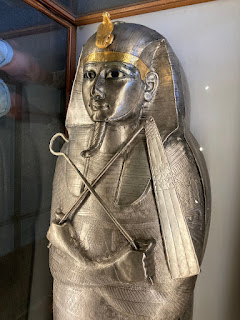












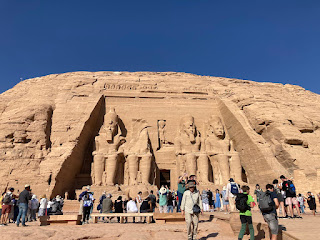



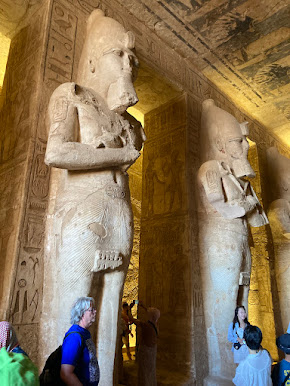


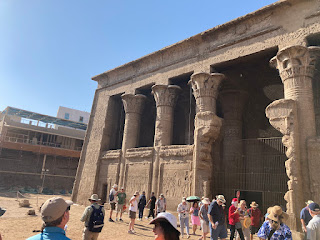





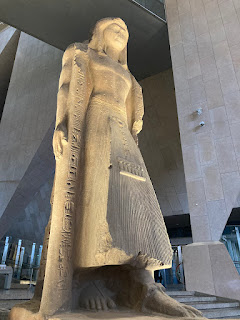




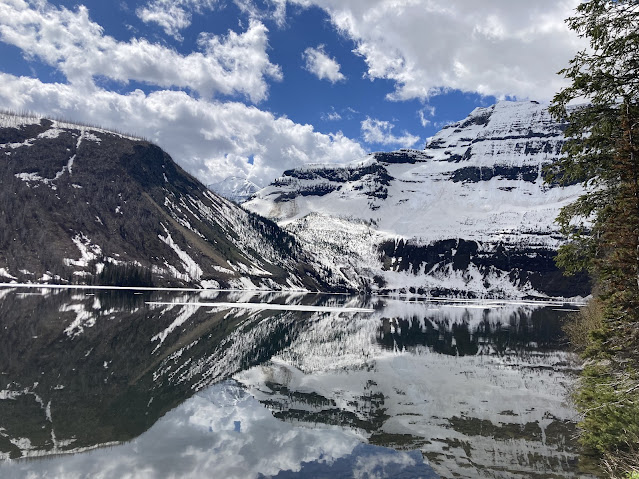

Comments
Post a Comment